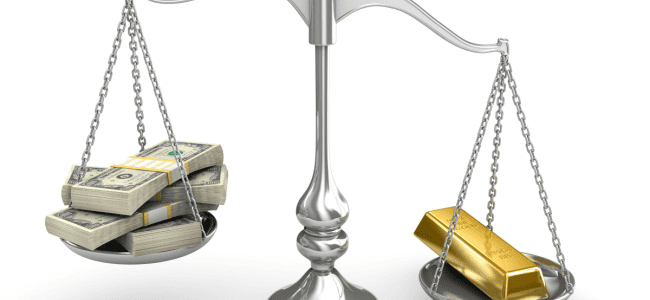Understanding Gold Inflation Impact on Investment Strategies
May 23, 2023

Inflation impact on Gold prices has been a topic of great interest among investors, particularly in times of economic uncertainty. Gold prices are known to vacillate in response to alterations in the money supply and CPI, serving as a protective buffer against inflation. In this blog post, we will delve into the intricacies surrounding gold inflation impact and its implications for investment strategies.
We’ll discuss how recent inflation reports have affected gold prices and explore the relationship between annual pace of inflation and potential pauses in interest rate hikes. Furthermore, we will examine investor expectations regarding interest rates and their influence on market trends and gold pricing.
In light of New York Fed President John Williams’ remarks on future interest rate moves, we will also consider how these uncertainties may affect commodities investments.
Table of Contents:
- Inflation Report Impact on Gold Prices
- Annual Pace of Inflation and Its Effects
- Investor Expectations and Interest Rates
- New York Fed President John Williams’ Remarks
- Previous Interest Rate Hikes Timeline
- FAQs in Relation to Gold Inflation Impact
- Conclusion
Inflation Report Impact on Gold Prices
The recent inflation report had a significant impact on gold prices, causing them to spike initially before dropping slightly due to profit-taking. This fluctuation was influenced by the consumer price index data for April and investors’ expectations regarding the Federal Reserve’s next move on interest rates.
Initial Spike in Gold Prices Following Inflation Report Release
Gold prices experienced an immediate surge following the release of April’s inflation report, as investors sought protection against potential increases in living costs. The precious metal is often viewed as an inflation hedge, making it an attractive investment option during times of economic expansion.
Subsequent Drop Due to Profit-Taking
Despite the initial spike in gold prices, they soon dropped as some traders decided to cash in their gains from the earlier rise. This profit-taking behavior can be attributed to market participants looking for short-term profits rather than long-term investments based on underlying fundamentals such as inflation trends or monetary policy decisions by central banks like the Federal Reserve.
- Influencing Factors: Consumer price index data and investor expectations played crucial roles in shaping gold price movements after the release of April’s inflation report.
- Inflation Hedge: As a traditional inflation protection asset, gold serves as a hedge against rising living costs and economic instability caused by high inflation.
- Volatile Market Behavior: The subsequent drop in gold prices highlights how quickly market sentiment can shift, with traders seeking short-term gains through profit-taking rather than focusing on long-term investment strategies.
Understanding the factors that drive gold price fluctuations is essential for investors looking to diversify their portfolios and protect their purchasing power from inflationary pressures. By staying informed about key economic indicators like consumer price index data and monitoring central bank decisions, individuals can make more informed choices when it comes to investing in precious metals such as gold.
The inflation report had a significant impact on gold prices, initially spiking and then dropping due to profit-taking. Going forward, it is essential to contemplate the yearly rate of inflation and its consequences in order to comprehend how this could shape future gold prices.
Key Takeaway:
The recent inflation report caused gold prices to initially spike before dropping due to profit-taking. Gold is viewed as an inflation hedge, making it attractive during times of economic expansion, but market sentiment can quickly shift with traders seeking short-term gains through profit-taking rather than focusing on long-term investment strategies.
Annual Pace of Inflation and Its Effects
The recent inflation report revealed that the annual pace of inflation was the lowest since April 2023. The Federal Reserve’s decisions on interest rate hikes could be affected by the recent report of the annual inflation rate being at its lowest since April 2023, which in turn might impact gold prices.
Lowest Annual Pace Since April 2023
In line with Wall Street expectations, the monthly increase in consumer price index data for April showed a controlled level of inflation. However, what caught investors’ attention was the fact that this marked the lowest annual pace since April last year. The lower-than-expected inflation figures could potentially ease concerns about an overheating economy and prompt a more cautious approach from policymakers when it comes to adjusting interest rates.
Potential Pause in Interest Rate Hikes
With seemingly controlled levels of inflation, there may be a pause in interest rate increases by the Federal Reserve. A series of interest rate hikes has been one of their key tools for managing economic growth and controlling inflationary pressures. However, if they perceive that these pressures are now under control or diminishing due to factors such as supply chain improvements or easing demand-side pressures, they might opt for a more gradual approach towards tightening monetary policy.
- Easing Demand-Side Pressures: As global economies recover from pandemic-induced disruptions and lockdowns gradually lift worldwide, pent-up consumer demand is expected to normalize over time – reducing upward pressure on prices.
- Supply Chain Improvements: Supply chains have faced unprecedented challenges during COVID-19; however, businesses continue adapting through technological advancements and strategic partnerships aimed at increasing efficiency – ultimately alleviating some of the inflationary pressures caused by supply bottlenecks.
Overall, a potential pause in interest rate hikes could have implications for gold prices. Gold is often considered an inflation hedge and tends to perform well when investors seek protection from rising prices. Yet, if the Fed opts to refrain from further rate hikes due to subdued inflationary pressures, this could potentially reduce appetite for gold as an investment option – causing its market value to fluctuate.
The low annual pace of inflation since April 2023 has caused investors to re-evaluate their expectations, leading into the discussion on how shifts in investor expectations can influence market trends and gold pricing. Investors’ choices and the subsequent consequences for gold costs can be examined with respect to interest rates.
Key Takeaway:
The recent inflation report showed the lowest annual pace since April 2023, potentially leading to a pause in interest rate hikes by the Federal Reserve. This could impact gold prices as it is often considered an inflation hedge and may see fluctuations in its market value due to changes in demand.
Investor Expectations and Interest Rates
Previously, investors had anticipated that the Fed would keep interest rates unchanged in June with a probability of 84.5%, but this expectation has now diminished significantly. Previously, there had been an assumed likelihood of 84.5% that the Fed would not alter interest rates in June; however, this prediction has since significantly decreased. However, this expectation has now decreased significantly.
Shifts in Investor Expectations
The change in investor sentiment can be attributed to various factors such as new economic data releases and statements from key policymakers like New York Fed President John Williams. As variables change, so too will investors’ outlooks on potential Federal Reserve rate decisions.
Influence on Market Trends and Gold Pricing
This shift in investor expectations has implications for market trends and gold pricing patterns. When investors anticipate that the Fed will maintain or lower interest rates, they may seek alternative investments like gold which tend to perform well during periods of low-interest-rate environments.
- Low-interest rates: In times when interest rates are low or expected to remain stable, gold often becomes more attractive as an investment option because it does not carry any counterparty risk associated with bonds or other fixed-income securities.
- Diversification benefits: Investors looking for diversification within their portfolios might also turn towards precious metals like gold due to its historical performance during periods of economic uncertainty or geopolitical tensions.
- Hedge against inflation: With concerns over rising inflation levels persisting globally, some investors view commodities such as gold as a hedge against potential losses caused by eroding purchasing power resulting from inflationary pressures.
As investor expectations continue to evolve, it is crucial for those interested in gold investments to stay informed about the latest market trends and economic data releases. This will enable them to make well-informed decisions regarding their investment strategies involving precious metals IRAs and other related financial instruments.
Investors’ outlooks are a significant element in influencing market movements and gold costs, yet central bank activities can likewise have an effect. As such, New York Fed President John Williams’ remarks on future interest rate moves should be closely monitored by investors considering investments involving commodities.
Key Takeaway:
Investor expectations about the Federal Reserve’s interest rate decision have shifted, causing implications for market trends and gold pricing patterns. Gold becomes more attractive during periods of low-interest-rate environments, offers diversification benefits, and can act as a hedge against inflation. It is crucial to stay informed about the latest market trends and economic data releases when making investment decisions involving precious metals IRAs.
New York Fed President John Williams’ Remarks
Recently, John Williams of the New York Fed caused a stir in the markets with his comments regarding potential further interest rate increases. He declared that it is yet to be seen if the Federal Reserve has finished its pattern of raising rates in this cycle. This comment comes amidst fluctuating gold prices and investor expectations regarding future interest rate moves.
Uncertainty Surrounding Future Interest Rate Moves
The remarks by Williams highlight the fact that there is still some ambiguity surrounding what actions the Federal Reserve may take in terms of adjusting interest rates moving forward. While investors were initially expecting a pause in rate hikes due to controlled inflation levels, these comments suggest that more increases could be on the horizon.
This uncertainty can have significant implications for various investment strategies, particularly those involving commodities like gold. As we know, changes in interest rates can directly impact gold prices as they influence market trends and investor behavior.
Implications for Investment Strategies Involving Commodities
- Risk Management: Investors should consider diversifying their portfolios with alternative assets such as precious metals IRAs offered by companies like American Alternative Assets. This approach can help mitigate potential risks associated with fluctuations in traditional asset classes caused by shifts in monetary policy.
- Informed Decision-Making: Staying up-to-date on economic indicators and central bank announcements will enable investors to make well-informed decisions about their investments based on current market conditions and anticipated future developments.
- Long-Term Perspective: While short-term market fluctuations can be challenging to navigate, it is essential for investors to maintain a long-term perspective and focus on their overall investment objectives. This approach will help ensure that temporary market shifts do not derail their financial goals.
In light of these remarks by the New York Fed President, investors should remain vigilant and adapt their strategies accordingly to account for potential changes in interest rates and subsequent impacts on gold prices. This is particularly important given that gold is often viewed as an inflation hedge and a means of protecting purchasing power during times of high inflation. Changes in the consumer price index and economic expansion can also impact gold prices, making it a valuable asset for investors to consider.
New York Fed President John Williams’ remarks highlighted the uncertainty surrounding future interest rate moves and their implications for investment strategies involving commodities. Moving on, let’s take a look at previous interest rate hikes timeline to understand how past increases have impacted gold price trends and subsequent investment strategies.
Key Takeaway:
New York Fed President John Williams’ recent statement about the uncertainty surrounding future interest rate moves has added ambiguity to the financial markets and impacted gold prices. Investors should consider diversifying their portfolios with alternative assets like precious metals IRAs, stay informed on economic indicators, and maintain a long-term perspective to mitigate potential risks associated with fluctuations in traditional asset classes caused by shifts in monetary policy.
Previous Interest Rate Hikes Timeline
The Federal Reserve’s series of interest rate hikes this year have had a notable impact on gold price trends and investor choices. Understanding the timeline of these past increases, as well as upcoming planned rate hikes, can provide valuable insight into potential market movements.
Past Interest Rate Increases
In 2023 alone, the Fed has raised rates three times by 25 basis points each time. These increases were aimed at controlling inflation and maintaining economic stability. As interest rates climb, investors may be motivated to seek out higher returns from alternative financial instruments than those provided by commodities such as gold.
Upcoming Planned Rate Hikes
According to recent statements by the Federal Reserve officials, there are plans for additional interest rate increases throughout 2023. The current schedule includes four more hikes totaling 75 basis points, set to occur in June, July, September, and November. Nevertheless, it is critical to bear in mind that these plans may be adjusted based on different elements like inflation figures or international economic conditions.
Impact on Gold Price Trends and Investment Strategies
- Influence of Past Hikes: Previous interest rate increases have typically led to downward pressure on gold prices due to shifts in investor preferences towards assets with higher yields.
- Ahead of Upcoming Hikes: Investors may adjust their portfolios before scheduled rate hikes take place, thus impacting gold prices ahead of actual policy changes.
- Varying Market Reactions: The market’s reaction to each interest rate hike can vary, depending on factors such as the overall economic climate and investor sentiment. This may result in different gold price trends following each increase.
As a conservative investor looking for alternative assets like precious metals IRAs, it is crucial to stay informed about the Federal Reserve’s actions regarding interest rates. By comprehending the implications of these choices on gold costs and investment techniques, you can make more informed selections when diversifying your portfolio.
Key Takeaway:
The Federal Reserve has implemented a series of interest rate hikes in 2023 to control inflation and maintain economic stability, leading investors to shift their focus from commodities like gold. There are plans for four more hikes totaling 75 basis points throughout the year, but these may change depending on various factors such as inflation data or global economic conditions. As a conservative investor looking for alternative assets like precious metals IRAs, it is crucial to stay informed about how these decisions impact gold prices and investment strategies.
FAQs in Relation to Gold Inflation Impact
How Does Inflation Impact Gold?
Inflation erodes the purchasing power of currency, making gold a popular hedge against it. As inflation rises, investors tend to shift their assets towards tangible commodities like gold, driving up its demand and price. However, this relationship is not always linear due to other market factors influencing gold prices.
Does Gold Go Up If Inflation Is High?
Gold often goes up when inflation is high because it retains its value better than paper currencies during such times. Investors flock to safe-haven assets like gold as a store of wealth and protection against rising prices. Nevertheless, external factors can sometimes affect this correlation.
Is It Good to Buy Gold During Inflation?
Purchasing gold during periods of high inflation can be a wise decision for diversifying your investment portfolio and preserving wealth. Gold’s historical performance shows that it has maintained or increased in value over time amid economic uncertainties or rising consumer prices.
Why Invest in Gold When Inflation Is High?
Investing in gold during high-inflation periods offers several benefits: protecting your purchasing power from currency devaluation; providing an alternative asset class for diversification; potentially profiting from increased demand for safe-haven investments; and acting as insurance against geopolitical risks or financial crises.
Conclusion
The lowest annual pace of inflation since April 2023 may result in a pause in interest rate hikes and shift investor expectations, influencing market trends and gold pricing. Uncertainty surrounding future interest rate moves raises implications for investment strategies involving commodities.
In summary, it is critical for investors to remain abreast of inflation rates and their probable influence on gold costs. For those interested in diversifying their portfolios with alternative assets like precious metals or real estate, American Alternative Assets offers expert guidance and personalized solutions tailored to individual financial goals.
Ready to explore your options? Contact American Alternative Assets today!












